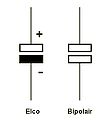| Revision as of 15:41, 15 October 2021 editGünniX (talk | contribs)Extended confirmed users311,006 editsm v2.04 - Fix errors for CW project (Tag with incorrect syntax)Tag: WPCleaner← Previous edit | Revision as of 11:50, 19 November 2021 edit undo159.242.109.226 (talk) →Standards for symbolsTags: Reverted possible vandalism references removedNext edit → | ||
| Line 3: | Line 3: | ||
| An '''electronic symbol''' is a ] used to represent various ] and ] devices or functions, such as ]s, ], ]s, and ]s, in a ] of an electrical or ]. These symbols are largely standardized internationally today, but may vary from country to country, or engineering discipline, based on traditional conventions. | An '''electronic symbol''' is a ] used to represent various ] and ] devices or functions, such as ]s, ], ]s, and ]s, in a ] of an electrical or ]. These symbols are largely standardized internationally today, but may vary from country to country, or engineering discipline, based on traditional conventions. | ||
| your ma smellls | |||
| ==Standards for symbols== | |||
| The graphic symbols used for electrical components in circuit diagrams are covered by national and international standards, in particular: | |||
| * ] 60617 (also known as ] BS 3939). | |||
| * There is also ] – for ladder-logic symbols. | |||
| * ] JIC (Joint Industrial Council) symbols as approved and adopted by the NMTBA (National Machine Tool Builders Association). They have been extracted from the Appendix of the NMTBA Specification EGPl-1967. | |||
| * ] Y32.2-1975 (also known as <ref>"IEEE Standard American National Standard Canadian Standard Graphic Symbols for Electrical and Electronics Diagrams (Including Reference Designation Letters)," in IEEE Std 315-1975 (Reaffirmed 1993) , vol., no., pp.i-244, 1993, doi: 10.1109/IEEESTD.1993.93397.</ref> or CSA Z99-1975). | |||
| * ] Std 91/91a: graphic symbols for logic functions (used in digital electronics). It is referenced in ANSI Y32.2/IEEE Std 315. | |||
| * Australian Standard AS 1102 (based on a slightly modified version of ] 60617; withdrawn without replacement with a recommendation to use IEC 60617). | |||
| The number of standards leads to confusion and errors.<ref>.</ref> | |||
| Symbols usage is sometimes unique to engineering disciplines, and national or local variations to international standards exist. For example, lighting and power symbols used as part of architectural drawings may be different from symbols for devices used in electronics. | |||
| ==Common electronic symbols== | ==Common electronic symbols== | ||
Revision as of 11:50, 19 November 2021
Pictogram used to represent various electrical and electronic devices or functions
An electronic symbol is a pictogram used to represent various electrical and electronic devices or functions, such as wires, batteries, resistors, and transistors, in a schematic diagram of an electrical or electronic circuit. These symbols are largely standardized internationally today, but may vary from country to country, or engineering discipline, based on traditional conventions.
your ma smellls
Common electronic symbols
Symbols shown are typical examples, not a complete list.
Traces
The large dot signifies an electrical connection.
-
 Trace connection
Trace connection
(IEC-style) -
 Trace junction
Trace junction
(IEC-style) -
 Trace crossing (unconnected)
Trace crossing (unconnected)
-
 Trace crossing
Trace crossing
(hand drawn schematics)
Grounds
The shorthand for ground is GND. Optionally, the triangle in the middle symbol may be filled in.
Sources
-
 Battery, single-cell
Battery, single-cell
-
 Battery, multi-cell
Battery, multi-cell
-
 Solar cell (photovoltaic cell)
Solar cell (photovoltaic cell)
-
 DC voltage source
DC voltage source
-
 Controlled DC voltage source
Controlled DC voltage source
-
 Current source
Current source
-
 Controlled current source
Controlled current source
-
 AC voltage source
AC voltage source
Resistors
See also: ResistorIt is very common for potentiometer and rheostat symbols to be used for many types of variable resistors, including trimmers.
-
 ANSI-style: (a) Resistor, (b) Rheostat,
ANSI-style: (a) Resistor, (b) Rheostat,
(c) Potentiometer / Trimmer -
 IEC-style: (a) Resistor, (b) Rheostat,
IEC-style: (a) Resistor, (b) Rheostat,
(c) Potentiometer / Trimmer -
 Thermistor or varistor
Thermistor or varistor
Capacitors
See also: Capacitor-
 General capacitor
General capacitor
(IEC-style) -
 Polarized capacitor
Polarized capacitor
(American-style) -
 Variable capacitor
Variable capacitor
-
 Ganged (co-moving) variable capacitors
Ganged (co-moving) variable capacitors
(IEC-style ) -
 Trimmer variable capacitor
Trimmer variable capacitor
Diodes
See also: DiodeOptionally, the triangle in these symbols may be filled in. There are multiple ways to draw a bridge rectifier symbol.
-
 Diode (rectifier)
Diode (rectifier)
-
 Schottky diode
Schottky diode
-
 Zener diode
Zener diode
-
 Light-emitting diode (LED)
Light-emitting diode (LED)
-
 Photodiode
Photodiode
-
 Tunnel diode
Tunnel diode
-
 Varicap
Varicap
-
 Shockley diode
Shockley diode
-
 Silicon-controlled rectifier (SCR)
Silicon-controlled rectifier (SCR)
-
 Diac (may be a varistor in older schematics)
Diac (may be a varistor in older schematics)
-
 Constant-current diode
Constant-current diode
-
 Opto-isolator: LED (left), photo transistor (right)
Opto-isolator: LED (left), photo transistor (right)
Bridge rectifiers
See also: Bridge rectifierThere are many ways to draw a single-phase bridge rectifier symbol. Some show the internal diode circuit, some don't.
Inductors
See also: Inductor-
 Air-core inductor
Air-core inductor
(IEC-style) -
 Magnetic-core inductor
Magnetic-core inductor
(IEEE-style) -
 Tapped inductor
Tapped inductor
(IEC-style) -
 Ferrite bead
Ferrite bead
(IEEE-style)
Transformers
See also: Transformer-
 Transformer
Transformer
-
 Transformer with center tap on secondary winding (right side)
Transformer with center tap on secondary winding (right side)
-
 Transformer with two secondary windings (right side)
Transformer with two secondary windings (right side)
-
 Current transformer
Current transformer
-
 Zero-sequence current transformer (ZSCT) (also known as a window-type current transformer)
Zero-sequence current transformer (ZSCT) (also known as a window-type current transformer)
-
 Bushing-type current transformer
Bushing-type current transformer
-
 Voltage transformer
Voltage transformer
Transistors
See also: TransistorUnipolar
See also: Field-effect transistorOptionally, these symbols may include a circle.
-
 N-channel junction gate field-effect transistor (JFET)
N-channel junction gate field-effect transistor (JFET)
-
 P-channel junction gate field-effect transistor (JFET)
P-channel junction gate field-effect transistor (JFET)
-
 Metal-oxide-semiconductor field-effect transistor (MOSFET)
Metal-oxide-semiconductor field-effect transistor (MOSFET)
-
 Enhancement mode, N-channel MOSFET
Enhancement mode, N-channel MOSFET
-
 Enhancement mode, P-channel MOSFET
Enhancement mode, P-channel MOSFET
Bipolar
See also: Bipolar junction transistorOptionally, these symbols may include a circle.
-
 NPN bipolar junction transistor (BJT)
NPN bipolar junction transistor (BJT)
-
 PNP bipolar junction transistor (BJT)
PNP bipolar junction transistor (BJT)
-
 NPN Darlington transistor
NPN Darlington transistor
-
 PNP Darlington transistor
PNP Darlington transistor
Vacuum tubes
See also: Vacuum tubeSwitches
See also: Switch-
 Switch, single-pole/single-throw (SPST)
Switch, single-pole/single-throw (SPST)
-
 Switch, single-pole/double-throw (SPDT)
Switch, single-pole/double-throw (SPDT)
-
 Switch, double-pole/double-throw (DPDT)
Switch, double-pole/double-throw (DPDT)
-
 Pushbutton, momentary or Spring-Return, make (IEEE-style)
Pushbutton, momentary or Spring-Return, make (IEEE-style)
-
 Pushbutton, momentary or spring-return, break (IEEE-style)
Pushbutton, momentary or spring-return, break (IEEE-style)
-
 Pushbutton, momentary or spring-return, two-circuit (IEEE-style)
Pushbutton, momentary or spring-return, two-circuit (IEEE-style)
Relays
See also: RelayLamps
LED is located in diode section.
-
 Neon lamp
Neon lamp
-
 Indicating lamp
Indicating lamp
(IEEE-style) -
 Incandescent lamp
Incandescent lamp
-
 Incandescent light bulb (as an indicator)
Incandescent light bulb (as an indicator)
-
 Light bulb
Light bulb
Current limiters
-
 IEC fuse (b), equivalent symbols (a, c) (IEEE Std 315-1975)
IEC fuse (b), equivalent symbols (a, c) (IEEE Std 315-1975)
-
 Moulded-case circuit breaker (MCCB)
Moulded-case circuit breaker (MCCB)
-
 Fuse: IEC (top) and American (lower two)
Fuse: IEC (top) and American (lower two)
Electro-acoustic devices
-
 Loudspeaker
Loudspeaker
(IEEE-style) -
 Buzzer
Buzzer
(IEC-style) -
 Microphone
Microphone
(IEEE-style) -
 Microphone
Microphone
(IEC-style)
Antennas
See also: Antenna (radio)-
 General antenna
General antenna
(IEC-style) -
 Dipole antenna
Dipole antenna
(IEC-style) -
 Loop antenna
Loop antenna
(IEC-style) -
 Loop antenna
Loop antenna
(IEEE-style)
Connectors
See also: Electrical connector-
 TRS phone jacks
TRS phone jacks
ICs
See also: Integrated circuitLogic gates
See also: Logic gatesFor the symbols below: A and B are inputs, Q is output.
There are variations of these logic gate symbols. Depending on the IC, the two-input gates below may have: 1) two or more inputs; 2) infrequently some have a second inverted Q output too.
The above logic symbols may have additional I/O variations too: 1) schmitt trigger input(s), 2) tri-state output, 3) open-collector or open-drain output (not shown).
-
 Buffer gate with schmitt trigger input
Buffer gate with schmitt trigger input
-
 Buffer gate with tri-state output control.
Buffer gate with tri-state output control.
(B is the tri-state control)
Flip-flops
See also: Flip-flopsFor the symbols below: Q is output, Q is inverted output, E is enable input, internal triangle shape is clock input, S is Set, R is Reset (some datasheets use clear (CLR) instead of reset along the bottom).
There are variations of these flip-flop symbols. Depending on the IC, a flip-flop may have: 1) one or both outputs (Q only, Q only, both Q & Q); 2) one or both forced inputs along top & bottom (R only, S only, both R & S); 3) some inputs may be inverted.
-
 Simple SR flip-flop (inverted S & R inputs)
Simple SR flip-flop (inverted S & R inputs)
-
 Gated SR flip-flop
Gated SR flip-flop
-
 Gated D flip-flop (Transparent Latch)
Gated D flip-flop (Transparent Latch)
-
 Clocked D flip-flop
Clocked D flip-flop
(Set & Reset inputs) -
 Clocked JK flip-flop
Clocked JK flip-flop
-
 Clocked T flip-flop
Clocked T flip-flop
OpAmps
-
 Operational amplifier (opamp)
Operational amplifier (opamp)
-
 Comparator
Comparator
Oscillators
See also: Electronic oscillator-
 Crystal oscillator
Crystal oscillator
(IEEE-style) -
 Ceramic resonator
Ceramic resonator
(3 pins)
Miscellaneous devices
-
 Hall-effect sensor
Hall-effect sensor
-
 Gas-discharge tubes (GDT) for ESD discharge
Gas-discharge tubes (GDT) for ESD discharge
-
 Spark gap
Spark gap
for ESD discharge
Historical electronic symbols
The shape of some electronic symbols have changed over time. The following historical electronic symbols can be found in old electronic books / magazines / schematics, and now considered obsolete.
Capacitors (historical)
All of the following are obsolete capacitor symbols.
-
 Obsolete capacitor
Obsolete capacitor
(very old style) -
 Obsolete capacitor
Obsolete capacitor
-
 Obsolete capacitor
Obsolete capacitor
-
 Obsolete capacitor
Obsolete capacitor
-
 Obsolete capacitor
Obsolete capacitor
See also
References
- Circuit Symbols for all Electronic Components. Talking Electronics, 2013. Retrieved 01 Apr 2015.
- Electrical Symbols & Electronic Symbols. RapidTables, 2012. Retrieved 17 April 2016.
- "Standards for Resistor Symbols". eePower. EETech Media. Retrieved September 13, 2021.
- "A4.11 Envelope or Enclosure". ANSI Y32.2-1975 (PDF).
The envelope or enclosure symbol may be omitted from a symbol referencing this paragraph, where confusion would not result
Further reading
- Beginner's Guide to Reading Schematics; 4th Ed; Stan Gibilisco; McGraw-Hill, 224 pages; 2018; ISBN 978-1260031119.
- How to Read Electronic Circuit Diagrams; 2nd Ed; Brown, Lawrence, Whitson; Tab Books; 214 pages; 1988; ISBN 978-0830628803.
- How to Read Schematic Diagrams; 4th Ed; Donald Herrington; Sams Publishing; 160 pages; 1986; ISBN 978-0672224577. (2nd Ed in 1967)
External links
- IEEE Standard American National Standard Canadian Standard Graphic Symbols for Electrical and Electronics Diagrams (Including Reference Designation Letters)
- IEC 60617 : Graphical Symbols for Diagrams (2012) - International standard
- MIL-STD-806B : Graphical Symbols for Logic Diagrams (1962) - U.S. DoD standard
- Electrical Schematic Symbols
- Collection of Open Source Electrical, Pneumatic, Hydraulic and Electronic Symbols
- Circuit Symbols of Electronic Components
- Electrical & Electronic Drawing Symbols
- Collection of Electrical and Electronic Symbols
- Circuit Schematic Symbols
- Collection of Electrical and Electronic Schematic Symbols





















